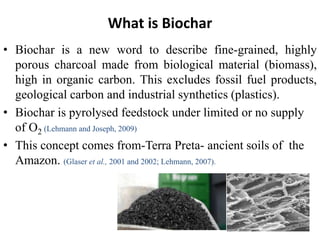Introduction of biochar
- 2. What is Biochar • Biochar is a new word to describe fine-grained, highly porous charcoal made from biological material (biomass), high in organic carbon. This excludes fossil fuel products, geological carbon and industrial synthetics (plastics). • Biochar is pyrolysed feedstock under limited or no supply of O2 (Lehmann and Joseph, 2009) • This concept comes from-Terra Preta- ancient soils of the Amazon. (Glaser et al., 2001 and 2002; Lehmann, 2007).
- 3. Biochar characterized as ÔÉò Recalcitrant aromatic structure (Downie et al., 2012; Lehmann, 2007), ÔÉò Highly porous and fine grained (Inyang et al ,2012), ÔÉò Hydrophobic in nature (Qiu et al., 2009), ÔÉò Small molecule with few fused aromatic rings (6-7) (Mao et al., 2012; Hiemstra, 2012) ÔÉò Variable in different composition (Atkinson et al., 2010; Lehmann and Joseph, 2009).
- 4. Pyrolysis Burning Ash Biochar Waste Biomass Figure 1. Schematic presentation of biochar and traditional ash production
- 5. Bangladesh and Biochar In Bangladesh, ÔÉò Soil OM status: most soil<1.5%, and some soils <1% (Fertilizer recommendation guide, 2005 ; 2012. p 48), ÔÉò Rapid decomposition of organic matter ÔÉò Deficiencies of macro and micro nutrients (Islam, 1992; Khan et al.,1997), ÔÉò Nutrient leaching and volatilization . ÔÉò Due to biochar application organic matter status and nutrient availability could be increased. ÔÉò A primary purpose for biochar is as soil enhancement to help retain nutrients and water , and habitat for the soil food web. ÔÉò Properly made and used, biochar can mitigate climate change and other environmental effects .
- 6. Soil amendment and C-sequestration • Increased fertility (Glaser 2007; Sombroek et al. 2002) • C- sequestration for >100yrs (Downie et al. 2012;Lehmann 2007) • 12% GHS reduction per year (Woolf, et al., 2010) Environmental Issues Pyrolysis Bioenergy • Bioenergy generation from biomass pyrolysis (Lehmann,2007, Laird,2008) Waste management • Use of waste for biochar production (Lehmann 2007)
- 7. Why it is good for plant ? Biochar is an organic soil amendment enhancer that: ÔÇß Increase soil fertility and agricultural yields ÔÇß Significantly enhances plant growth & root development. ÔÇß Boosts plant nutrient retention. ÔÇß Improves soil structure and stability. ÔÇß Improves soil water holding capacity & permeability. ÔÇß Retains nitrogen and phosphorus in the soil. ÔÇß Helps healthy activity of soil micro-fauna & flora. ÔÇß Suppresses odour & breaks down pollutants from soil.
- 8. Biochar stove Easy way of Production An Example of Biochar production what I did in my Experiment: ÔÉò Forty five (45) kg dry sawdust, ÔÉò Used fuel was 12 kg fuel ÔÉò Average residence time was (5 hours) ÔÉò Temperature was >350 0 C (approximately), ÔÉò Produced biochar was 10 kg
- 9. Picture: Biochar stove , Poultry litter and Biochar
- 10. Nutrient availability & retention (Blackwell et al., 2010) Water holding capacity (Brewer et al., 2012; Major et.al, 2011) Crop yield (Asai et al., 2006; Tagoe et al., 2008) Habitat for Microorganisms (Lehmann et al. 2011) Reduces nutrient leaching (Brockh et al., 2010) Physical properties of soil (Busscher et al., 2010) C-sequestration (Downie et al. 2012; Lehmann, 2007) Soil pH & CEC (Glaser et al.,2002; Biochar with Soil
- 11. Fe & Al hydr(oxydes) PO4 –OM competition Soil organic matter Humic acids Fulvic acids Humin Soil organisms Organic inputs (biochar) ElevatedN supply Mineralization Nutrient uptake Immobilization Inorganic inputs (N+P+K) ElevatedPO4 Decomposition NH4 + High CEC and elevatedIon binding to organic matter ElevatedBNF Figure 2. Schematic representation of Biochar alone with NPK fertilizers activity in soil for plant growth and biological nitrogen fixation (BNF). 2 3 1
- 12. Biochar has high CEC. So it can increase nutrient retention capacity and increase nutrient use efficiency by binding NH4 + Biochar increase P availability as they release small molecules of organic matter, which are more competent for PO4 . The C/N ratio of Biochar is high as a result, part of the mineral is immobilized . That is biochar application increase BNF. Moreover, Biochar itself has a positive effect on nodulation due to favourable condition for symbiotic bacteria.
- 13. THANKS TO ALL













